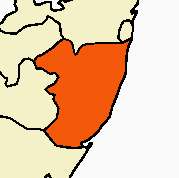Madras Atomic Power Station
| Madras Atomic Power station சென்னை அணுமின் நிலையம் | |
|---|---|
 Location of Madras Atomic Power station சென்னை அணுமின் நிலையம் in India | |
| Country | India |
| Coordinates | 12°33′27″N 80°10′30″E / 12.55750°N 80.17500°ECoordinates: 12°33′27″N 80°10′30″E / 12.55750°N 80.17500°E |
| Construction began | 1970 |
| Commission date | 24 January 1984 |
| Operator(s) | Nuclear power Corporation of India Ltd |
| Power generation | |
| Units operational | 2 × 235 MW |
| Units under const. | 1 × 500 MW |
| Units planned | 2 × 600 MW |
| Average generation | 2,311 GWh |
|
Website Nuclear power Corporation of India Ltd | |
Madras Atomic Power Station (MAPS) (Tamil:சென்னை அணுமின் நிலையம்) located at Kalpakkam about 80 kilometres (50 mi) south of Chennai, India, is a comprehensive nuclear power production, fuel reprocessing, and waste treatment facility that includes plutonium fuel fabrication for fast breeder reactors (FBRs). It is also India's first fully indigenously constructed nuclear power station. It has two units of 220 MWe capacity each. The first and second units of the station went critical in 1983 and 1985 respectively. The station has reactors housed in a reactor building with double shell containment ensuring total protection even in the remotest possibility of loss-of-coolant accident. An Interim Storage Facility (ISF) is also located in Kalpakkam.
Currently the Prototype Fast Breeder Reactor (PFBR), a 500 MWe fast breeder nuclear reactor, has been constructed at the location, and is expected to reach criticality in March 2017.[1] Liquid sodium is planned to be loaded by the end of 2016.[2]
History
During its construction, a total of 3.8 lakh (380,000) railway sleeper (logs) were brought from all over India to lift the 180 t critical equipment in the first unit, due to lack of proper infrastructure and handling equipment.[3]
Reactors
The facility houses two indigenously built Pressurised Heavy-Water Reactors (PHWRs) called MAPS-1 and MAPS-2. MAPS-1 was completed in 1981, but start-up was delayed due to a shortage of heavy-water. After procuring the necessary heavy-water, the MAPS-1 went critical in 1983 and began operating at full power on 27 January 1984. MAPS-2 obtained criticality in 1985 and began full power operations on 21 March 1986.[4] The two Pressurised Heavy-Water Reactors (PHWR) are capable of generating 170 MWe each which is lower than the designed power of 235 MWe since some Zircaloy pieces from the cracked cooling system were found in a moderator pump.[5]
A beachhead at Kalpakkam also hosts India's first indigenous Pressurised (light) water reactor (PWR). The 80 MW reactor was developed by Bhabha Atomic Research Centre (BARC) as the land-based prototype of the nuclear power unit for India's nuclear submarines.[6] This unit does not come under MAPS.
See also
References
- ↑ Singh, Jitendra (28 July 2016). "Answer on 28.07.2016 to Rajya Sabha unstarred question no.1184 to Government of India Department of Atomic Energy" (PDF). dae.nic.in. Department of Atomic Energy, Government of India. Archived (PDF) from the original on 8 August 2016. Retrieved 8 August 2016.
PFBR is poised for first criticality by March, 2017.
- ↑ Rohit, T.K. (30 July 2016). "Prototype Fast Breeder Reactor likely to be delayed". www.thehindu.com. The Hindu. Archived from the original on 30 July 2016. Retrieved 8 August 2016.
- ↑ "MAPS Silver Jubilee Celebration". India Environment Portal.
- ↑ Plants Under Operation - Nuclear Power Corporation of India Limited. Npcil.nic.in. Retrieved on 2013-12-06.
- ↑ "NTI: Country Overviews: India: Nuclear Facilities Madras Atomic Power Station (MAPS)". Nuclear Threat Initiative. September 2003. Retrieved 29 November 2009.
- ↑ "PWR building shows indigenous capability, says Kakodkar". The Hindu. Chennai, India. 3 August 2009.
External links
- Nuclear power Corporation of India Ltd
- Plants Under Operation: Madras Atomic Power Station
- NTI India Profile
- shreyashss.blogspot.in
